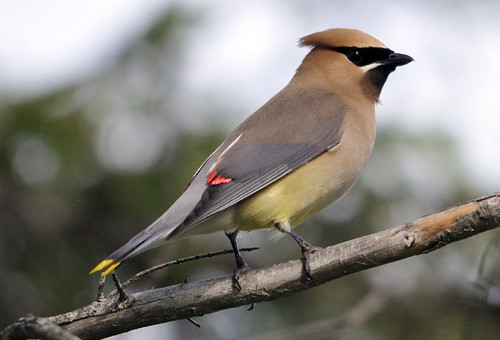Singing for Their Supper: Gardening to Attract Migratory Songbirds . . .
 Viburnum plicatum var. tomentosum ‘Shasta’ Fruits in the Garden – A Cedar Waxwing Favorite
Viburnum plicatum var. tomentosum ‘Shasta’ Fruits in the Garden – A Cedar Waxwing Favorite
Late in summer, when tall grass sways in golden light and crickets sing long into morning, the garden begins to ripen in shades of red, orange, violet and plum. In August, migratory birds —making their way to exotic, tropical destinations— flock to my garden like jet-setters pausing for a gourmet meal and quick rest at a hip, mountain-top resort. Cedar Waxwings, with their high whistling calls, are the happening crowd this week; flitting about and flashing their glorious plumage and dark masks in fruity Viburnums …
 Cedar Waxwing â“’ Bill Thompson/USFWS
Cedar Waxwing â“’ Bill Thompson/USFWS
Beautiful birds are as important to my garden as any of the plants growing within it. In order to attract and support birds, I’ve planted a wide variety of fruiting trees, shrubs and seed-producing perennials in the landscape. The Viburnum genus is especially attractive to songbirds, and with so many species and cultivars to choose from, it’s easy to find more than one to fit in any garden. Viburnum plicatum var. tomentosum (featured previously here) is a beautiful shrub that provides season-spanning support for wildlife. In addition to Viburnums, I grow a number of Dogwood (Cornus) species, Ninebark (Physocarpus opulifolius), Winterberry (Ilex verticillata), Juniper, Spicebush (Lindera benzoin), Ornamental Sumac (Rhus typhina), Elderberry (Sambucus), Buckeye (Aesculus) and many other fruit-bearing shrubs.
 Nannyberry Viburnum (V. lentago) Fruits Ripen from Citrusy Hues to Blueish Black. The Coral Colored Stems Make a Stunning Contrast to the Dark-Hued Berries. Although Birds Eventually will Pick the Shrub Clean, There’s Plenty of Time to Enjoy the Visual Feast as Well…
Nannyberry Viburnum (V. lentago) Fruits Ripen from Citrusy Hues to Blueish Black. The Coral Colored Stems Make a Stunning Contrast to the Dark-Hued Berries. Although Birds Eventually will Pick the Shrub Clean, There’s Plenty of Time to Enjoy the Visual Feast as Well…
Creating a bird-friendly habitat also means providing water —fresh, clean birdbath or water feature— and shelter. Conifers and shrubs with dense branching patterns offer excellent cover and protection from predators and the elements. Hemlock (Tsuga), Spruce (Picea), Fir (Abies) and Cedar (Thuja) are important sources of both food and shelter for birds throughout the seasons. For more information on attracting birds, visit Cornell-University’s Lab of Ornithology here. And for additional photos and berry-good planting ideas, click back to my earlier post —Oh Tutti-Fruitti— here.
 Kousa Dogwood (Cornus kousa) Berries Provide Sustenance to a Variety of Birds and Squirrels From Late Summer through Early Winter
Kousa Dogwood (Cornus kousa) Berries Provide Sustenance to a Variety of Birds and Squirrels From Late Summer through Early Winter
 Magical Callicarpa dichotoma ‘Issi’ is Not Only a Beautiful Ornamental, but a Magnet for Feathered Garden Guests as Well!
Magical Callicarpa dichotoma ‘Issi’ is Not Only a Beautiful Ornamental, but a Magnet for Feathered Garden Guests as Well!
All Other Photographs and Text â“’ Michaela Medina/The Gardener’s Eden. All images, articles and content on this site (with noted exceptions), are the original, copyrighted property of The Gardener’s Eden and may not be reposted, reproduced or used in any way without prior written consent. Contact information is in the left side bar. Please do not take my photographs without asking first. Thank you!Â
Do you enjoy The Gardener’s Eden? You can help support this site by shopping through affiliate links. A small percentage of each sale will be paid to this site, helping to cover web hosting and maintenance costs. Thank you so much for your support!
3 Replies to “Singing for Their Supper: Gardening to Attract Migratory Songbirds . . .”
Comments are closed.

Michela, I have that first viburnum in my garden. It has been there for two years and has never bloomed. It is in full sun for half the day and then is shaded by the house in the afternoon. We have acidic clay soil, and it is planted on a bit of a slope. Do I need to feed it something?
Thanks, Lynda
Hi Linda, Although you say you have had the shrub for two years, you didn’t mention it’s size or actual age. If your plant is very small/young, this could be the issue. V. plicatum does best in moist, If the soil is very heavy, this might be a problem and if the soil is very, very acidic, then you have a problem there as well. V. plicatum prefers woodsy, slightly acidic soils with a good amount of organic matter (leaf compost). This is a fairly shade tolerant shrub and blooms well in the forest understory, so sun isn’t the issue for you. If the soil is very acidic and very dense, and if the plant seems otherwise unhappy (slow growth, stunted foliage) soil may be at issue. You could try fertilizing in early spring, after leaves emerge, with 10-10-10. Be careful not to over-apply fertilizer. Apply compost and mulch at the base of the plant to provide natural food and conserve moisture/keep down weeds.
Shasta should be a strong bloomer. If it doesn’t bloom and yet seems otherwise healthy, I would wonder if you have a mis-marked cultivar.
Good luck! M
Sadly it’s August – confirmed by the appearance of the Cedar Wax Wing and Bluejay – suddenly returned from the cool(er) depths of the woods… xo D.